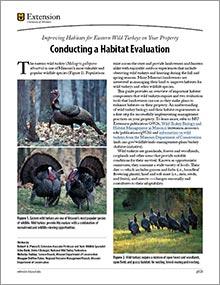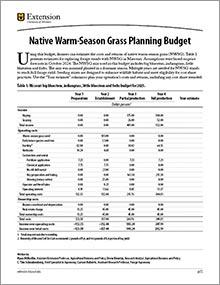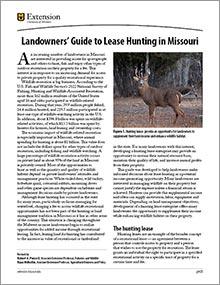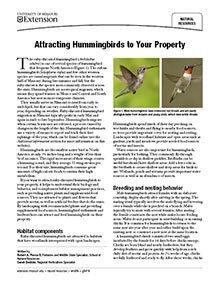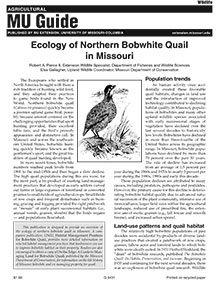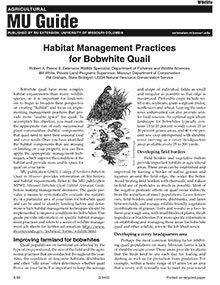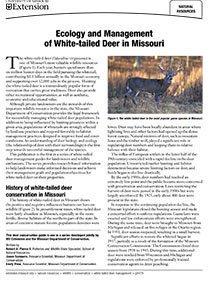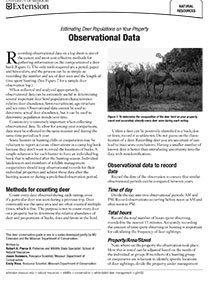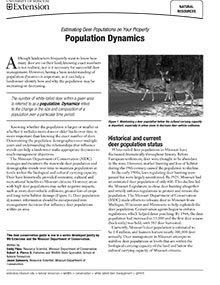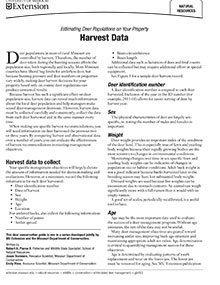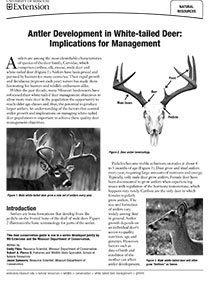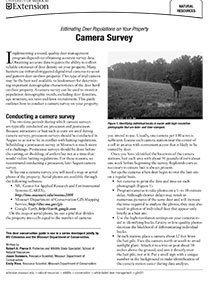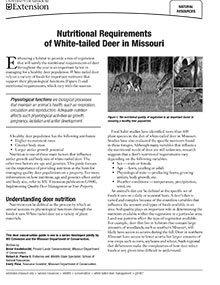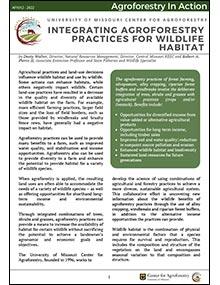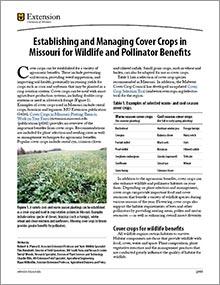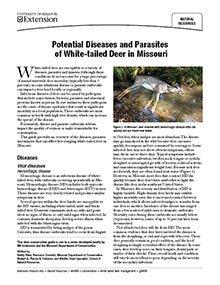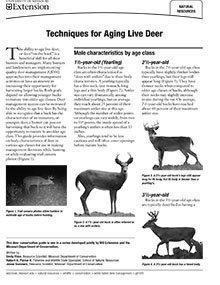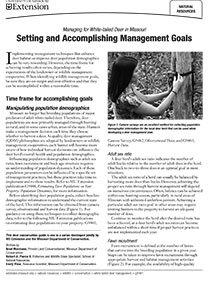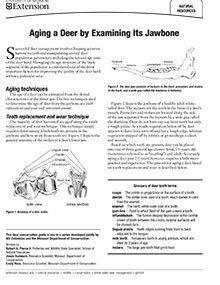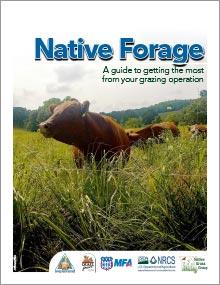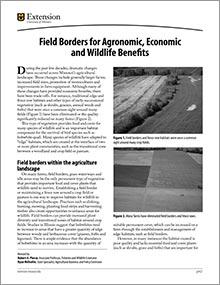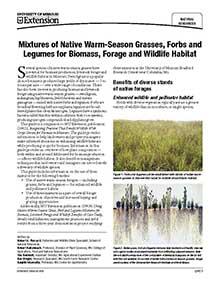The following publications cover topics related to Wildlife Ecology and Management. For a complete list of MU Extension publications, visit the main Publications page.
Improving Habitats for Eastern Wild Turkeys on Your Property: Conducting a Habitat Evaluation
New
Get an overview of important habitat components that wild turkeys require and two evaluation tools you can use as you make plans to enhance habitats on your property.
Native Warm-Season Grass Planning Budget
Revised
Use this enterprise budget to plan costs and returns for establishing and managing native warm-season grass forages for hay and pasture on Missouri farms.
Landowners’ Guide to Lease Hunting in Missouri
Revised
If you're leasing property for hunting, then learn about lease arrangement options, prices or rates to charge, liability, and how to write a contract.
Attracting Hummingbirds to Your Property
Revised
Learn how to attract ruby-throated hummingbirds to your property by understanding their behavior and providing suitable habitat and food sources.
Habitat Management Practices for Bobwhite Quail
Revised
If you are a landowner considering lease hunting as a potential income-generating opportunity, learn what you need to consider beforehand. Sample leases are included in this University of Missouri Extension guide.
Ecology and Management of White-Tailed Deer in Missouri
Reviewed
The white-tailed deer is one of Missouri’s most valuable wildlife. Visit our site to learn about the Ecology and Management of White-Tailed Deer in Missouri.
Estimating Deer Populations on Your Property: Observational Data
Reviewed
When collected appropriately, observational data can be useful. Visit our site for our Estimating Deer Populations on Your Property: Observational Data guide.
Estimating Deer Populations on Your Property: Population Dynamics
Reviewed
Deer populations are hard to calculate. Visit our site to view our resource on Estimating Deer Populations on Your Property: Population Dynamics.
Estimating Deer Populations on Your Property: Harvest Data
Reviewed
White-tailed deer management
This deer conservation guide is one in a series developed jointly by MU Extension and the Missouri Department of Conservation.
Antler Development in White-tailed Deer: Implications for Management
Reviewed
Antlers are among the most identifiable characteristics of species of the deer family. Visit our website to learn about antler development.
Estimating Deer Populations on Your Property: Camera Survey
Reviewed
White-tailed deer management
This deer conservation guide is one in a series developed jointly by MU Extension and the Missouri Department of Conservation.
Nutritional Requirements of White-tailed Deer in Missouri
Reviewed
White-tailed deer rely on a variety of foods for nutrients. Learn how to enhance habitat on your property to maintain a healthy white-tailed deer population.
Integrating Agroforestry Practices for Wildlife Habitat
Revised
Learn how to incorporate management of trees, shrubs and grasses with your current farm practices to benefit white-tailed deer, eastern wild turkey, bobwhite quail, waterfowl and mourning doves.
Establishing and Managing Cover Crops in Missouri for Wildlife and Pollinator Benefits
New
Learn how to establish and manage cover crops in Missouri to improve soil, attract wildlife, and support pollinators year-round.
Potential Diseases and Parasites of White-tailed Deer in Missouri
Reviewed
White-tailed deer are susceptible to a variety of issues. Visit our site to learn about Potential Diseases and Parasites of White-tailed Deer in Missouri.
Techniques for Aging Live Deer
Reviewed
The ability to age live deer is a beneficial skill for all deer hunters and managers. Visit our site to learn Techniques for Aging Live Deer.
Managing for White-tailed Deer in Missouri: Setting and Accomplishing Management Goals
Reviewed
White-tailed deer management
This deer conservation guide is one in a series developed jointly by MU Extension and the Missouri Department of Conservation.
Quail-Friendly Plants of the Midwest
Reviewed
Learn how to identify plants important to bobwhites in the Midwest so that you can critically evaluate the food and cover components of habitat on your land.
Aging a Deer by Examining Its Jawbone
Reviewed
Managing the age structure of bucks is considered very important for improving the quality of the deer herd. Visit our site to learn about aging a deer.
Managing for White-tailed Deer in Missouri: Establishing a Wildlife Management Cooperative
Reviewed
Establishing a wildlife management cooperative enables landowners to collaboratively enhance white-tailed deer habitats and improve hunting opportunities.
Establishing Fruit and Nut-Bearing Trees and Shrubs for Wildlife Habitat in Missouri
New
Learn how to successfully establish and manage trees and shrubs for wildlife benefits. This guide includes a table of fruit-bearing trees and shrubs recommended for planting in Missouri to attract specific types of wildlife.
Native Forage: A Guide to Getting the Most From Your Grazing Operation
New
Adding warm-season grass areas to a grazing system that already features cool-season grass creates a forage system that allows livestock owners to keep their herds feeding on high-quality forage for more of the year.
Field Borders for Agronomic, Economic and Wildlife Benefits
Revised
Learn how to make and maintain field borders to reduce soil erosion from wind and water, protect soil and water quality and provide wildlife and pollinator habitat.
Establishing Mixtures of Native Warm-Season Grasses and Forbs for Potential Biomass, Forage and Wildlife Habitat
New
Learn about the species of native warm-season grasses with potential for biomass production, livestock forage and wildlife habitat in Missouri — switchgrass, indiangrass, big bluestem, little bluestem and eastern gamagrass — in this MU Extension guide.
